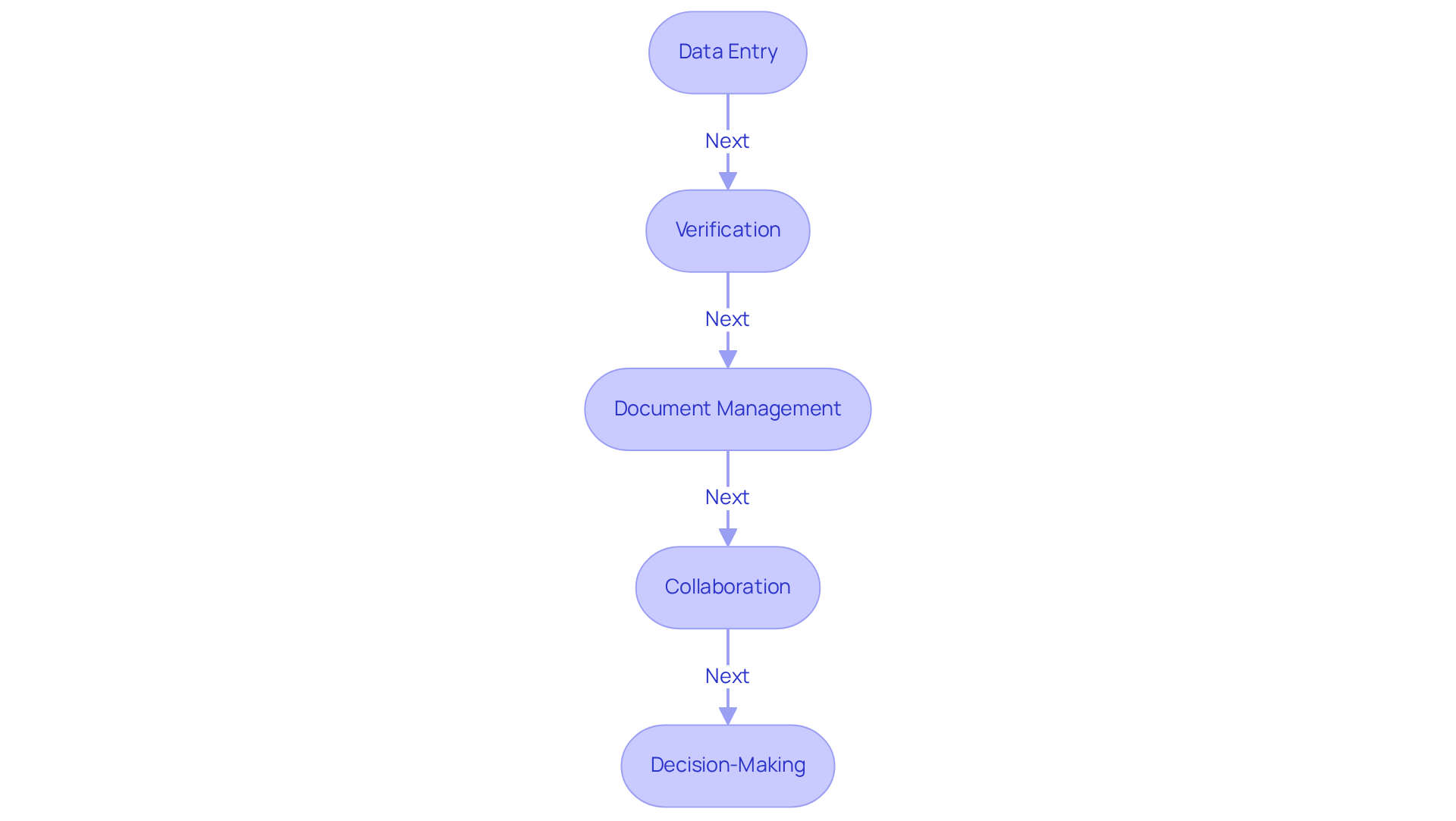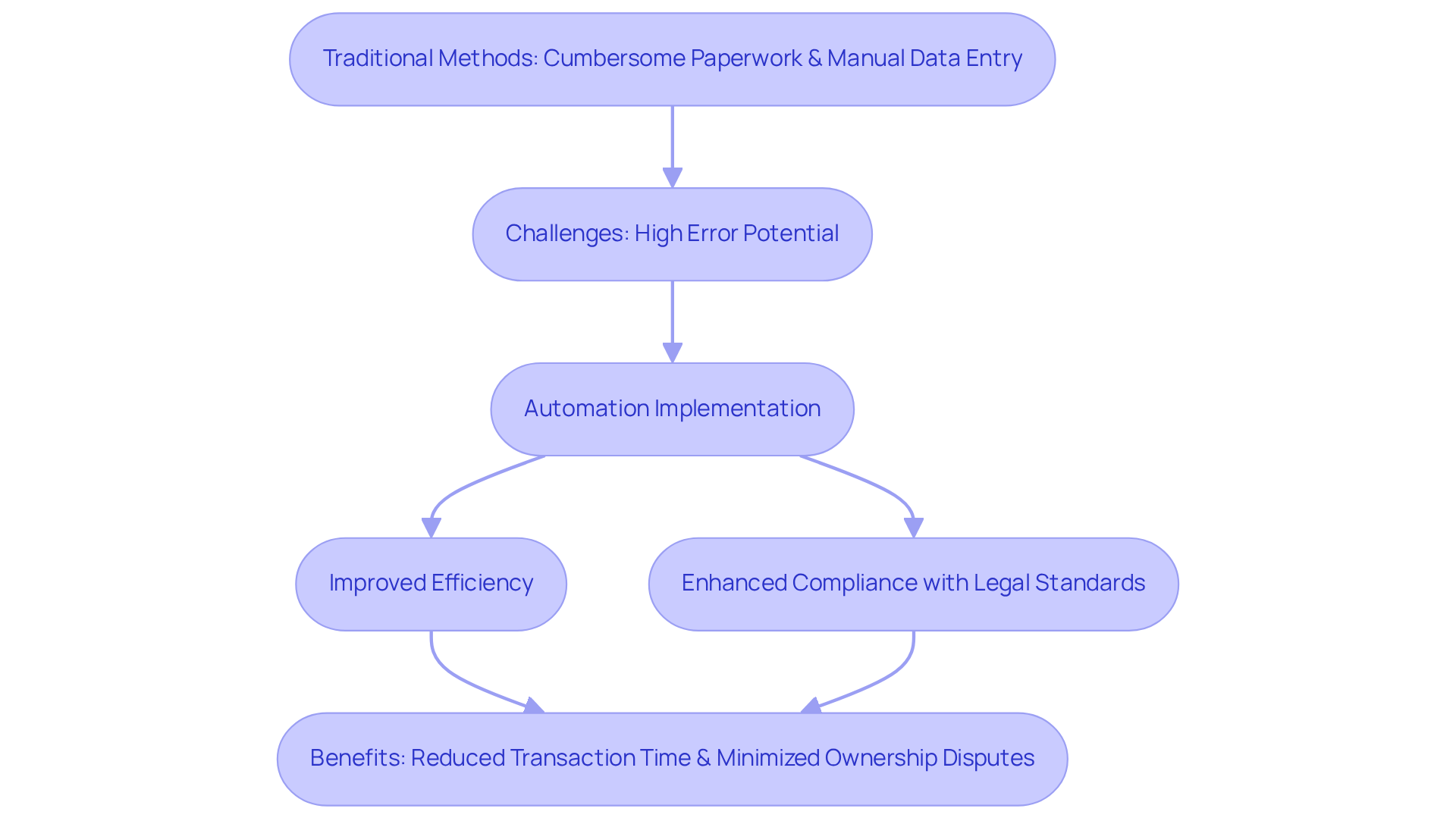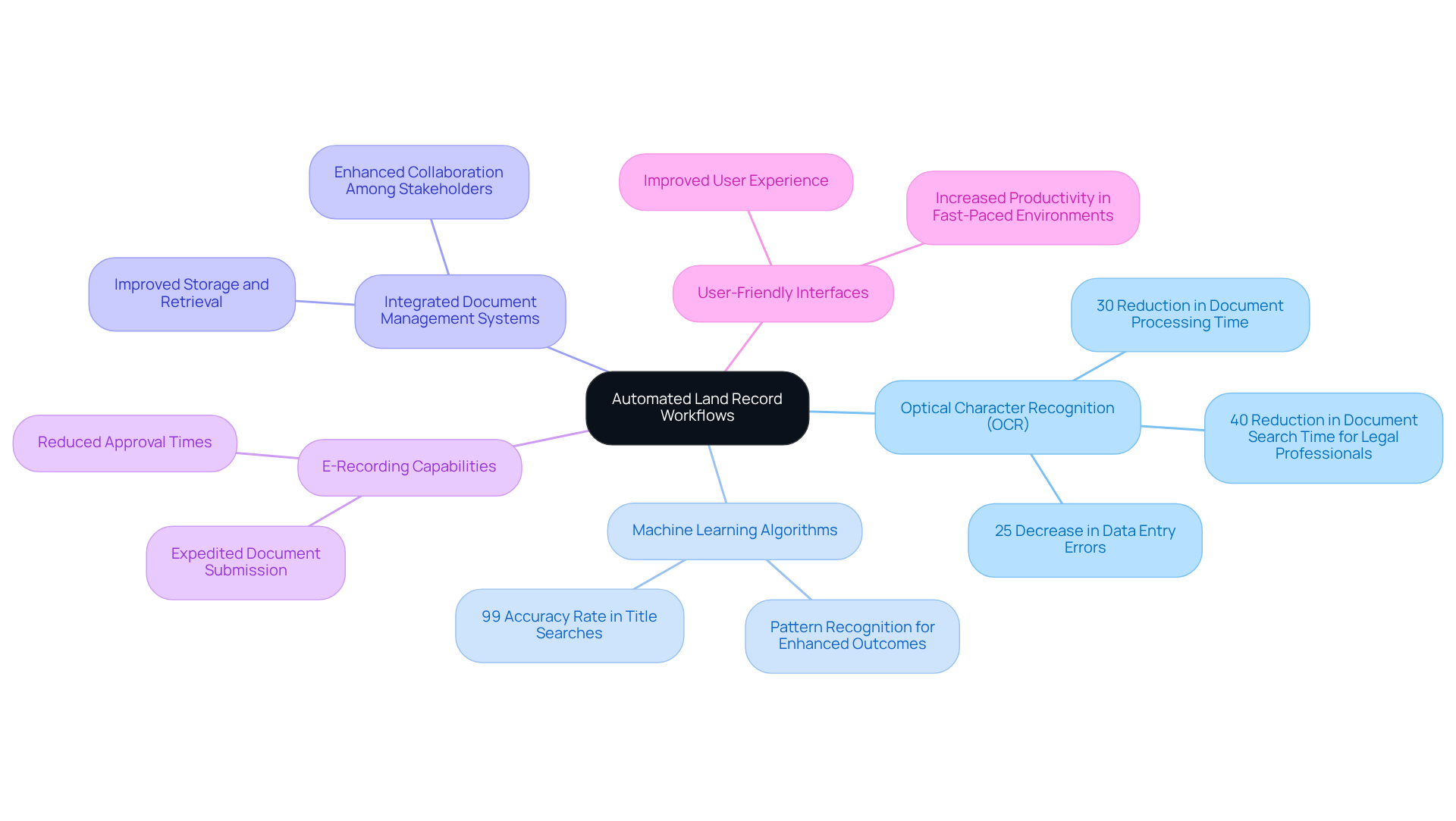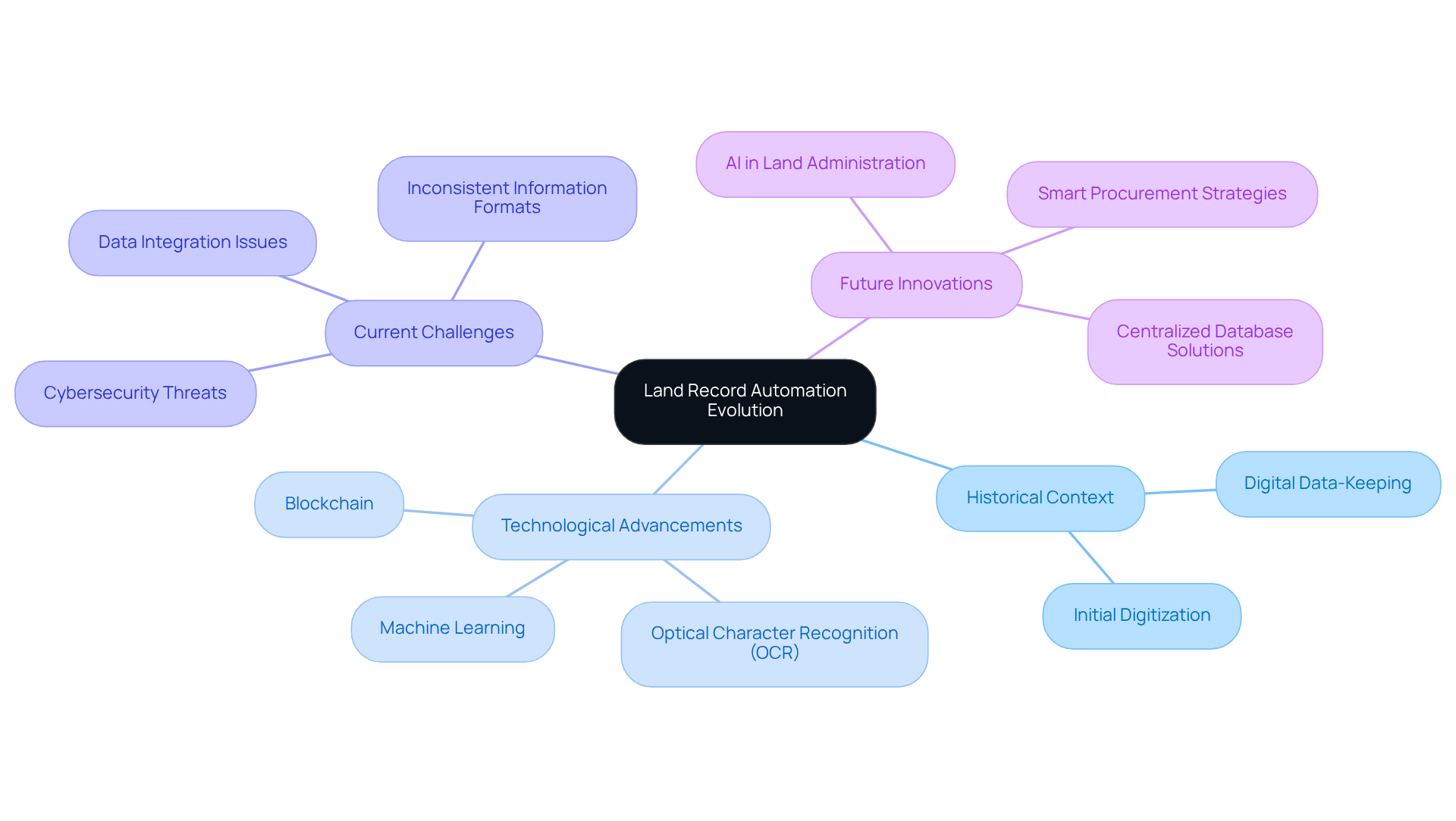Overview
Automated land record workflows play a crucial role in enhancing the efficiency and accuracy of title research. By leveraging technologies such as Optical Character Recognition (OCR) and machine learning, these workflows streamline the management of property documentation. This article demonstrates that such innovations significantly reduce processing times and errors. Consequently, real estate professionals can concentrate on strategic tasks, which ultimately leads to improved productivity and operational efficiency in property management.
Introduction
Automated land record workflows are revolutionizing property documentation management, offering a streamlined approach that significantly enhances both efficiency and accuracy. By integrating advanced technologies such as optical character recognition and machine learning, these workflows reduce tedious tasks and empower real estate professionals to focus on strategic decision-making.
Furthermore, despite these promising benefits, a staggering 90% of automation projects fail. This statistic raises critical questions about the challenges of implementation and the future of property management in an increasingly digital landscape.
Define Automated Land Record Workflows
The overview of automated land record workflows represents systematic procedures that leverage technology to efficiently manage, record, and retrieve land ownership information. These procedures integrate sophisticated digital tools, including machine learning and optical character recognition, to enhance the management of title documents. By automating monotonous tasks such as data entry and verification, these processes can decrease repetitive activities by 60-95%, resulting in time savings of up to 77% on regular tasks. This significant enhancement in accuracy and speed allows real estate professionals to redirect their efforts toward more strategic activities, ultimately improving overall productivity and operational efficiency.
Furthermore, the incorporation of such technologies not only simplifies processes but also enhances collaboration and decision-making, providing an overview of automated land record workflows that are crucial for contemporary property management. As the market for workflow automation is projected to reach US$18.45 billion by 2025, the importance of these automated systems continues to grow. In addition, as noted by industry experts, "the benefits it serves are insurmountable in terms of resource-saving and automation efficiency."
However, it is crucial to acknowledge that 90% of automation projects fail due to technical issues, highlighting the need for careful implementation. Firms such as DocuClipper illustrate effective technology incorporation in property management, employing automation for streamlined information extraction.

Context and Importance of Automation in Land Records
The automation of property documentation has become increasingly significant, as seen in the overview of automated land record workflows, due to the rising number of real estate transactions and the complexity of ownership. Traditional methods often involve cumbersome paperwork, manual data entry, and a high potential for errors. In fact, approximately 60% of all positions encompass at least 30% of constituent activities that can be automated, highlighting the substantial potential for automation in property management.
Automation addresses these challenges by offering an overview of automated land record workflows, which provides a more efficient and reliable method for managing property documentation. It not only reduces the time needed to process transactions but also enhances compliance with legal standards, thereby minimizing risks associated with property ownership disputes.
As Lawrence Yun, NAR Chief Economist, notes, "Increasing participation in the housing market will increase the mobility of the workforce and drive economic growth," underscoring the importance of efficient processes in real estate. Furthermore, case studies such as 'Digital Transformation and Industry 4.0' demonstrate that businesses embracing automation have experienced improved accuracy and efficiency.
As the real estate market evolves, having an overview of automated land record workflows is crucial for maintaining competitiveness and ensuring precision in title research.

Key Components and Characteristics of Automated Workflows
Key components of automated land record workflows include:
-
Optical Character Recognition (OCR): This technology scans and transforms physical documents into digital formats, enabling swift information extraction and significantly enhancing processing times. Financial organizations that implemented OCR solutions noted a 30% reduction in document processing time and a 25% decline in entry mistakes. Furthermore, 40% of legal professionals reported that OCR technology helped reduce document search time by half, underscoring its effectiveness in legal contexts.
-
Machine Learning Algorithms: These algorithms analyze historical data to identify patterns and predict outcomes, enhancing the accuracy of title searches. By leveraging machine learning, organizations can achieve an impressive accuracy rate of up to 99%, which is crucial for minimizing errors in title research workflows.
-
Integrated Document Management Systems: These systems enhance the storage, retrieval, and sharing of property documents, ensuring that all stakeholders have access to the most current information. This integration fosters collaboration and enhances decision-making processes.
-
E-Recording Capabilities: This feature allows for the electronic submission of documents to relevant authorities, expediting the recording process and reducing the time required for approvals.
-
User-Friendly Interfaces: Intuitive interfaces improve user experience, making it easier for title researchers to navigate complex data sets. This accessibility is vital for maintaining productivity in fast-paced environments.
Together, these elements establish a unified process that provides an overview of automated land record workflows, greatly improving the effectiveness and dependability of property documentation management and ultimately resulting in superior service provision in title research. Moreover, the Intelligent Document Processing (IDP) market is expected to expand at a CAGR of 28.9%, emphasizing the growing significance of these technologies in property management processes. As Tajammul Pangarkar noted, implementing IDP can potentially cut processing time by 50% or more, eliminating errors and profoundly boosting productivity and efficiency.

Evolution and Technological Advancements in Land Record Automation
The emergence of automated land record workflows can be traced to the introduction of digital data-keeping systems in the late 20th century. Initially, these systems aimed to digitize existing paper records, enhancing accessibility. As technology has advanced, particularly with the evolution of Optical Character Recognition (OCR) and machine learning, these systems have transformed into sophisticated platforms capable of managing complex information analysis and real-time updates.
The overview of automated land record workflows demonstrates that they not only streamline the recording process but also enhance information accuracy and compliance with legal standards. However, organizations face significant challenges related to cybersecurity threats and data integration issues, which are crucial for maintaining the integrity of property records management.
As technology continues to evolve, future innovations may include the integration of blockchain to facilitate secure and transparent property transactions, further revolutionizing the field of title research. To fully harness the advantages of these advancements, organizations must embrace emerging standards for information security and prioritize stakeholder training, ensuring that personnel are well-equipped to effectively leverage AI in land administration.

Conclusion
Automated land record workflows represent a transformative approach to managing property documentation, utilizing advanced technologies to streamline processes and enhance accuracy. By integrating tools such as Optical Character Recognition and machine learning, these workflows significantly reduce the time and effort required for title research, allowing real estate professionals to focus on higher-value tasks. The shift towards automation is not merely a trend; it is a necessity for maintaining efficiency and competitiveness in an increasingly complex market.
Key insights from the discussion reveal that automation can decrease repetitive tasks by up to 95% and save time by as much as 77%. Furthermore, the incorporation of integrated document management systems and e-recording capabilities enhances the efficiency of property transactions, while user-friendly interfaces ensure that professionals can navigate complex data with ease. However, the potential for failure in automation projects underscores the importance of careful implementation and ongoing training to maximize the benefits of these technologies.
As the landscape of real estate continues to evolve, embracing automated land record workflows is crucial for organizations aiming to improve operational efficiency and reduce risks associated with property ownership. The future of title research lies in leveraging these technological advancements, ensuring that stakeholders are well-equipped to navigate the complexities of property management in a digital age. Embracing automation not only enhances productivity but also fosters a more reliable and transparent environment for real estate transactions, paving the way for sustainable growth in the industry.
Frequently Asked Questions
What are automated land record workflows?
Automated land record workflows are systematic procedures that utilize technology to efficiently manage, record, and retrieve land ownership information, enhancing the management of title documents.
What technologies are integrated into automated land record workflows?
These workflows incorporate advanced digital tools such as machine learning and optical character recognition to improve efficiency.
How much can automation reduce repetitive tasks in land record management?
Automation can decrease repetitive activities by 60-95%, leading to time savings of up to 77% on regular tasks.
What are the benefits of implementing automated land record workflows for real estate professionals?
The significant enhancements in accuracy and speed allow real estate professionals to focus on more strategic activities, improving overall productivity and operational efficiency.
How does automation impact collaboration and decision-making in property management?
The incorporation of automation simplifies processes, thereby enhancing collaboration and decision-making within the property management sector.
What is the projected market size for workflow automation by 2025?
The market for workflow automation is projected to reach US$18.45 billion by 2025.
What challenges are associated with automation projects?
It is noted that 90% of automation projects fail due to technical issues, emphasizing the need for careful implementation.
Can you provide an example of effective technology incorporation in property management?
Firms like DocuClipper demonstrate effective technology use by employing automation for streamlined information extraction in property management.




